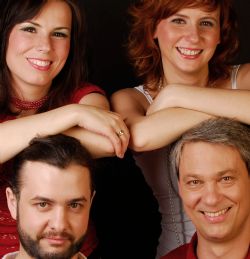|
Symphony
FROM THE NEW WORLD TO THE OLD WORLD
by Peter Lert
Saturday, June 14, 2025
Chamber
MC2 DUO RECITAL CLOSES 222'S SEASON
by Terry McNeill
Saturday, June 14, 2025
Choral and Vocal
CANTIAMO SONOMA'S LUSCIOUS A CAPELLA SINGING IN SEASON ENDING CONCERT
by Pamela Hicks Gailey
Sunday, June 8, 2025
Symphony
SRS SEASON ENDS WITH RESOUNDING TA-TA-TA-BANG
by Terry McNeill
Sunday, June 1, 2025
Symphony
YOUTHFUL VIRTUOSITY ON DISPLAY AT USO'S MAY CONCERTS
by Peter Lert
Saturday, May 17, 2025
Symphony
MYSTICAL PLANETS AND LIVELY GERSHWIN ORTIZ AT FINAL SRS CONCERT
by Peter Lert
Sunday, May 4, 2025
Symphony
VSO'S CONCERT MUSIC OF TIME, MUSIC OF PLACE
by Peter Lert
Sunday, April 27, 2025
VOCAL ELEGANCE AND FIRE AT THE 222'S RECITAL APRIL 26
by Pamela Hicks Gailey
Saturday, April 26, 2025
CANTIAMO SONOMA SINGS AN INSPIRED GOOD FRIDAY MOZART REQUIEM CONCERT
by Pamela Hicks Gailey
Friday, April 18, 2025
DRAMATIC SHOSTAKOVICH SYMPHONY CLOSES PHILHARMONIC'S 25TH SEASON
by Terry McNeill
Sunday, April 13, 2025
|
 |
 Škampa String Quartet |
ANGUISHED AUTOBIOGRAPHY
by Steve Osborn
Saturday, October 23, 2010
Chamber music ensembles come and go, sometimes in their entirety, sometimes player by player. When a first violinist leaves a string quartet, for example, the group either dissolves or scrambles to find a replacement. Rarely, however, do two players leave at once, but such is the case with the Czech Republic’s two-decade-old Skampa String Quartet, which appeared for its concert in Occidental on Oct. 23 boasting not one but two new violinists since its last appearance in Sonoma County two years ago.
At the 2008 concert, held at Santa Rosa Junior College, the Skampa players stood (excepting the cello) and delivered a memorable rendition of Smetana’s first string quartet, “From My Life.” This year the quartet sat and delivered an equally memorable rendition of an equally autobiographical quartet, the Shostakovich No. 8.
Getting to the “memorable” category wasn’t easy. The two new violinists, Helena Jiríkovská (first) and Daniela Soucková (second), had big shoes to fill, a task made harder by their diminutive frames and less than compelling stage presences. Jiríkovská in particular was rigidly focused on her score, in stark contrast to the emotive cellist Lukás Polák and the founding violist Radim Sedmidubsky, who played many passages from memory.
The Skampa began their concert in the new Occidental Center for the Arts with the two extant middle movements from Haydn’s last quartet fragment, Op. 103. As Sedmidubsky said, the fragment is a good concert opener, and it showed off the clean acoustics of the new Center, a converted elementary school gymnasium. As befitting its former small inhabitants, the gym is on a petite scale, seating about 100, with a three-foot-high stage at the south end. Dominating the stage is a set of sound reflectors (they looked like birch plywood), with matching reflective “clouds” hanging from the ceiling.
The audience sits on cloth-covered stacking chairs, either on the central floor or on raised platforms in the back. Sight lines are excellent, and the stage lighting is subdued. Adding to the pleasant mix is an open kitchen on the west wall from which refreshments are served at intermission. For this performance, almost every chair was filled, despite the torrential rain outside.
Compared to the Center’s former cramped quarters at the Occidental Community Church, the acoustics have somewhat less presence, perhaps because of the sound-absorbing tiles on the gym’s ceiling. One hopes that the new Center is a work in progress, however, so further adjustments can be made.
Back to the Skampa, which dispatched the Haydn with precision and clarity but not much in the way of feeling. That latter quality began to show through in the next work, the last quartet (Op. 106) of their countryman Antonin Dvorak. This infrequently performed work makes considerable technical demands on all the players and features a dizzying succession of melodic ideas. Just when Dvorak seems to have settled into a theme, he leapfrogs into another musical universe.
The Skampa approached Dvorak’s quartet with considerable energy, but they often seemed in too much of a hurry to let the piece sing. Despite his extroverted playing, the cellist emitted a thin tone, and the first violinist was frequently detached from the rest of the group. The second violinist had a better sound and seemed more engaged; her solo at the beginning of the second movement was particularly impressive. Holding everything together was the veteran violist Sedmidubsky, who leaned out from his chair at the left end of the quartet to play his occasional solos to the audience.
All the notes and dynamics were there, but the performance never caught fire. Thankfully, the conflagration did arrive after a lengthy intermission. Following a helpful introduction by Sedmidubsky, the Skampa eased into the Shostakovich with a sustained pianissimo, setting the stage for the sudden fortissimo of the work’s rollicking second theme. They played with conviction and certainty, blending their instruments beautifully and creating a striking unanimity of sound.
The rest of this memorable quartet, which many consider to be Shostakovich’s finest, was equally well played. Most important, the Skampa invested real meaning into the work, making Shostakovich’s anguished musical autobiography come alive. After the quiescent and somber ending, the audience sat for a moment in complete silence, holding their tumultuous applause until the musicians stood up. The standing ovation was well deserved.
|
